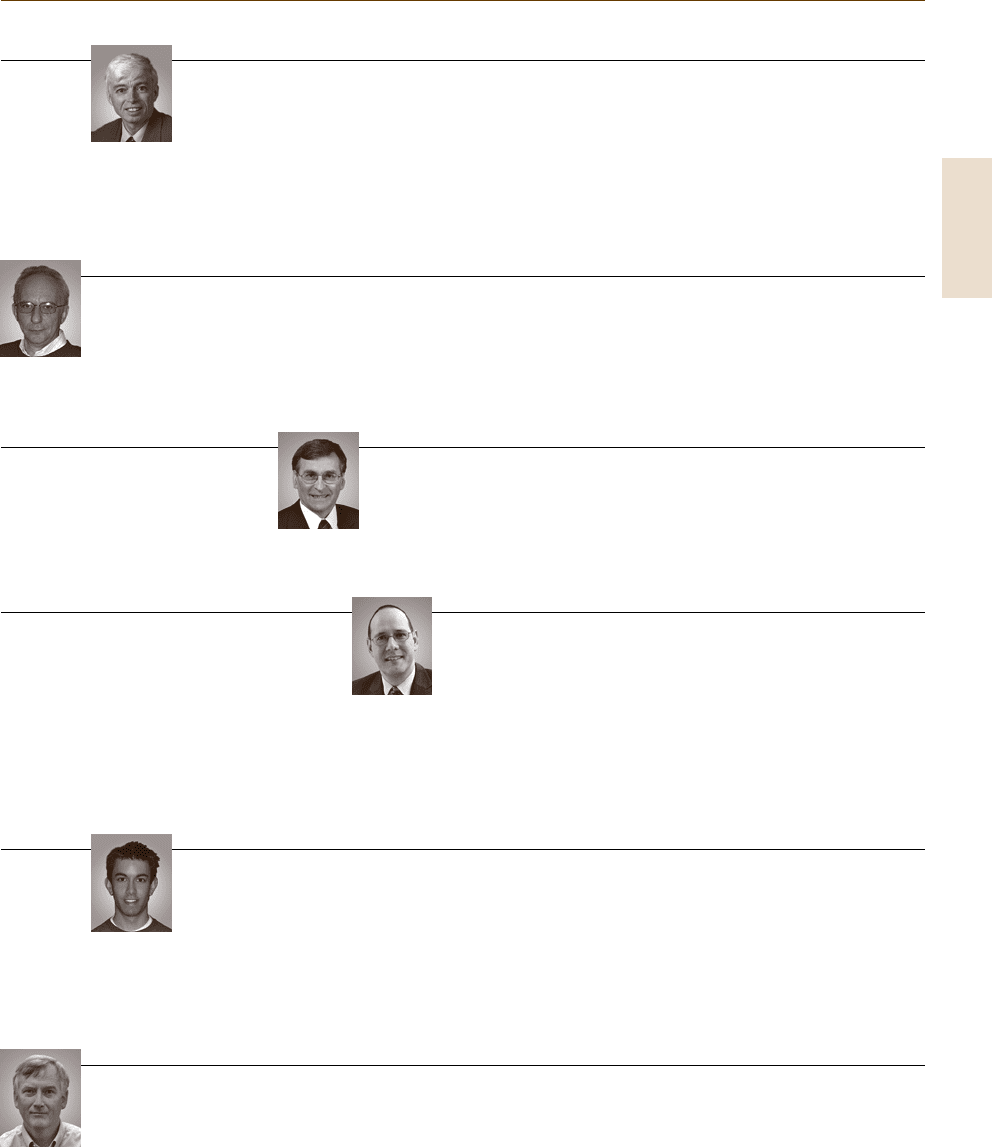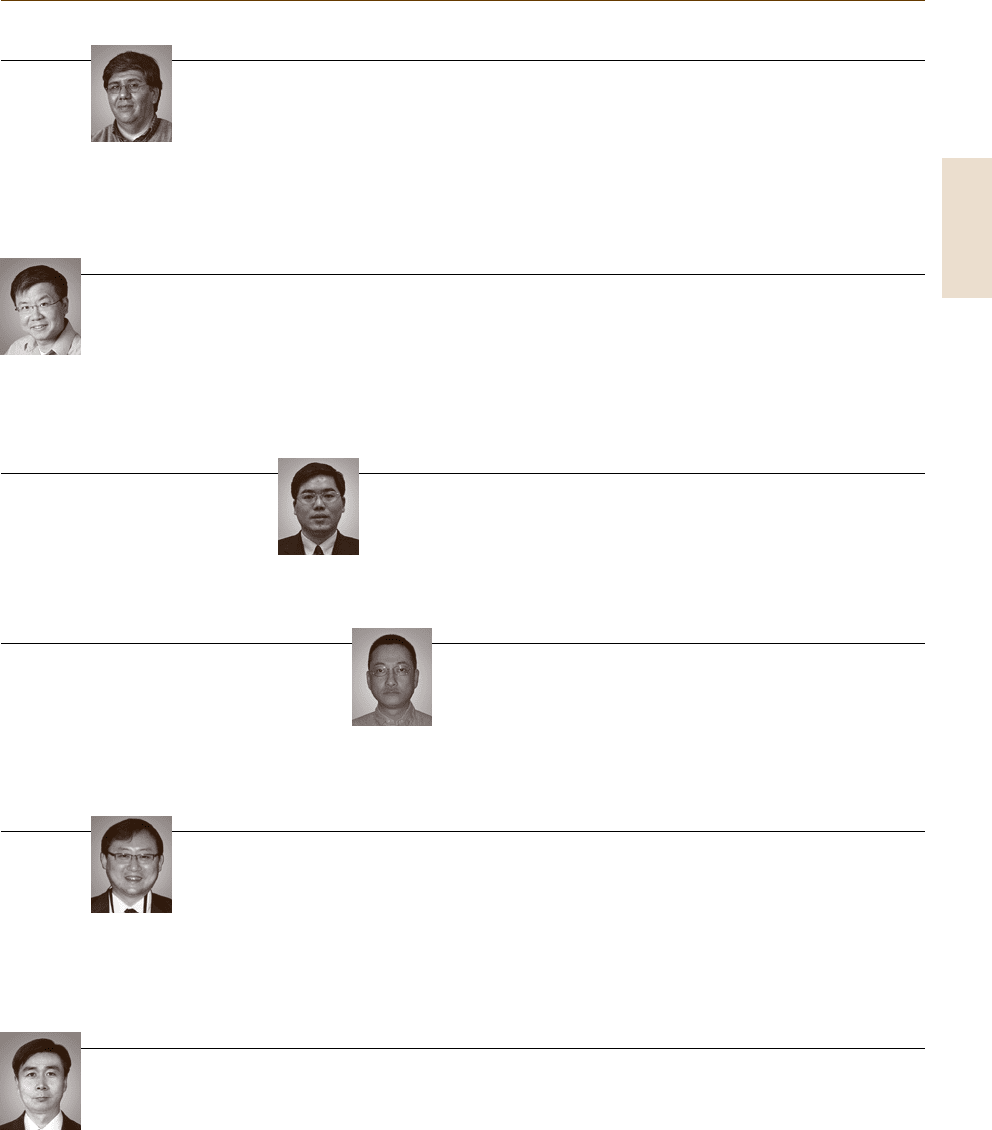Nof S.Y. Springer Handbook of Automation
Подождите немного. Документ загружается.


Acknowledgements 1705
Thanks to A. Signore for preparing the manuscript. The
authors thank Dr. C.R. Wanke for peer-reviewing the
content presented in this chapter.
H.75 Automatic Control in Systems Biology
by Henry Mirsky, Jörg Stelling,
Rudiyanto Gunawan, Neda Bagheri,
Stephanie R. Taylor, Eric Kwei,
Jason E. Shoemaker, Francis J. Doyle III
The authors gratefully acknowledge significant ed-
itorial help in preparing this chapter by Xin W. Chen
from the PRISM Center at Purdue University. The
authors also gratefully acknowledge financial support
from the Institute for Collaborative Biotechnologies
(ICB) through the United States Army Research Office
(ARO) (Grants DAAD19-03-D-0004 and W119NF-07-
1-0279), from the National Institutes of Health (NIH)
(Grants EB007511 and GM078993), from the Integra-
tive Graduate Education Research Traineeship National
Science Foundation (IGERT NSF) (Grant DGE02-
21715), from the Defense Advanced Research Projects
Agency (DARPA) BioComp and BioSpice Programs,
from the Research Participation Program between the
United States Department of Energy (DOE) and Air
Force Research Laboratory, Human Effectiveness Di-
rectorate (AFRL/HEP), and from the University of
California, Board of Regents.
H.79 Rotary Heart Assist Devices
by Marwan A. Simaan
This research was supported in part by NSF
under grants ECS-0300097 and ECCS-0701365 and
NIH/BHLBI under contract 1R43HL66656-01. The
contributions of Drs. James F. Antaki and J. Robert
Boston and our students Leonardo Baloa, Darryl
Breitenstein, Shaohui Chen, Antonio Ferreira, and Yih-
Chong Yu are gratefully acknowledged.
H.80 Medical Informatics
by Chin-Yin Huang
The author would like to thank Chen Ching General
Hospital and DVNET Technologies Co. for providing
the precious pictures in this chapter. Research projects
93-2218-E-029-001 and 94-2213-E-029-013 are also
gratefully acknowledged for the knowledge discovery
on breast cancer patient records, supported by the Na-
tional Science Council, Taiwan.
H.81 Nanoelectronic-Based Detection
for Biology and Medicine
by Samir M. Iqbal, Rashid Bashir
The authors would like to acknowledge and thank
Oguz H. Elibol and Bala Murali K. Vekatesan for
help with literature collection, and Salman B. Inayat
and Syed H. Shah for manuscript review. S.M. Iqbal
acknowledges support from University of Texas at Ar-
lington Research Enhancement Program.
I.85 Automation in Education/Learning Systems
by Kazuyoshi Ishii, Kinnya Tamaki
The case studies were supported by The Re-
search Center for e-Learning Professional Competency
(eLPCO) in the Research Institute of Aoyama Gakuin
University and The Research Center for Social and In-
dustrial Management Systems of Kanazawa Institute of
Technology. We would like to thank the staff of the
organization for their cooperation with these studies.
Also, one of the cases was supported in part by a grant-
in-aid for Scientific Research of the Japanese Ministry
of Education, Culture, Sports, Science, and Technology
under contract number C19510160 (2007–2008).
I.88 Collaborative e-Work, e-Business, and e-
Service
by Juan D. Velásquez, Shimon Y. Nof
Research reported in this chapter has been devel-
oped at the PRISM Center of Purdue University with
NSF, Indiana 21st Century fund for Science and Tech-
nology, and substantial industry support.
Special thanks are due to: our colleagues, our visit-
ing scholars, and the many students at the PRISM Lab
and the PRISM Global Research Network worldwide;
and the International Foundation of Production research
(IFPR) and the International Federation of Automatic
Control (IFAC) Committee CC5 for Manufacturing and
Logistics Systems, many of whom are also chapter co-
authors in this Handbook. They have all collaborated
with us to develop, over many years, e-work and collab-
orative control theory knowledge.
I.92 e-Government
by Dieter Rombach, Petra Steffens
The authors would like to thank the following per-
sons for valuable comments, enlightening discussion,
Acknowl.

1706 Acknowledgements
and help in producing this chapter: Prof. Dr. Frank
Bomarius, Savitha Chennagiri, Ines Grützner, Thomas
Jeswein, Dr. Jürgen Münch, Dr. Reinhard Schwarz, and
Dr. Michael Tschichholz.
I.93 Collaborative Analytics
for Astrophysics Explorations
by Cecilia R. Aragon
The author would like to thank the Sunfall devel-
opers and scientists of the SNfactory collaboration, in
particular Greg Aldering, Stephen Bailey, Karl Runge,
Sarah Poon, and Rollin Thomas. This work was sup-
ported in part by the Director, Office of Science, Office
of Advanced Scientific Computing Research, of the US
Department of Energy under Contract No. DE-AC02-
05CH11231, and by the Director, Office of Science,
Officeof HighEnergy Physics, ofthe US Department of
Energy under Contract No. DE-FG02-92ER40704, and
by a grant from the Gordon & Betty Moore Foundation.
This research used resources of the National Energy
Research Scientific Computing Center, which is sup-
ported by the Office of Science of the US Department
of Energy under Contract No. DE-AC02-05CH11231.
J.94 Automation Statistics
by Juan D. Velásquez, Xin W. Chen,
Sang Won Yoon, Hoo Sang Ko
The authors wish to thank all the many colleagues
and sources who helped in developing this chapter. At
the same time, while we did our best to be comprehen-
sive, we apologize if we mistakenly missed any relevant
data. We will be able to include it in future editions.
Acknowl.

1707
About the Authors
Nicoletta Adamo-Villani Chapter D.37
Purdue University
Computer Graphics Technology
West Lafayette, IN, USA
nadamovi@purdue.edu
Nicoletta Adamo-Villani is Associate Professor of Computer Graphics Technology at
Purdue University. She received her MS in Architecture from University of Florence,
Italy in 1993 and she is a certified 3-D modeller/animator for Autodesk. Adamo-
Villani is an award-winning animator and creator of 2-D/3-D films that aired on
national television. Her research interests focus on the application of 3-D animation to
education, HCC (human–computer communication), and visualization.
Panos J. Antsaklis Chapter B.13
University of Notre Dame
Department of Electrical Engineering
Notre Dame, IN, USA
antsaklis.1@nd.edu
Panos J. Antsaklis is the Brosey Professor of Electrical Engineering and Concurrent
Professor of Computer Science and Engineering at the University of Notre Dame.
His research interests are in control and automation, particularly in networked control
and hybrid systems emphasizing interdisciplinary research in control, computing and
communication networks. He has authored books on Linear Systems, Discrete Event,
Hybrid and Networked Control Systems.
Cecilia R. Aragon Chapter I.93
Lawrence Berkeley National Laboratory
Computational Research Division
Berkeley, CA, USA
CRAragon@lbl.gov
Cecilia Aragon is a Staff Computer Scientist in the Computational
Research Division at Lawrence Berkeley National Laboratory. Her
research interests include visualization,image processing, visualanalytics,
computer-supported cooperative work, and human–computer interaction.
She received her PhD in computer science from the University of
California, Berkeley and her BS in mathematics from the California
Institute of Technology. She is a Senior Member of the IEEE.
Neda Bagheri Chapter H.75
Massachusetts Institute of Technology
(MIT)
Department of Biological Engineering
Cambridge, MA, USA
nbagheri@mit.edu
Neda Bagheri earned her MS/PhD (2007) in Electrical Engineering from
the University of California Santa Barbara with emphasis in Control
Theory and Systems Biology. As a postdoctoral researcher at MIT, she
currently investigates combinatorial cancer therapy through dynamical
systems modeling integrated tightly with quantitative experiments. Her
primary research interest focuses on addressing challenges in medicine
and biology using principles from control theory.
Greg Baiden Chapter F.57
Laurentian University
School of Engineering
Sudbury, ON, Canada
gbaiden@laurentian.ca
Dr. Baiden is a Mining Professor specializing in robotics and mining automation in
the School of Engineering at Laurentian University. Dr. Baiden lead mining research
at Inco Ltd prior to joining Laurentian University and creating Penguin Automated
Systems Inc. His research investigates robotics and automation for many types of
systems such as underground, surface, underwater and in space. His recent work
includes the newly patented high bandwidth communication systems.
Authors

1708 About the Authors
Parasuram Balasubramanian Chapter G.71
Theme Work Analytics Pvt. Ltd.
Bangalore, India
balasubp@gmail.com
Parasuram Balasubramanian holds engineering and management degrees from IIT,
Madras and a doctorate from Purdue University. He has been with the Information
Technology industry in India, Jamaica and USA and has been a featured speaker in
many conventions. He specializes in business analytics and plays a proactive role to
bridge industry and academia on the research front.
P. Pat Banerjee Chapter B.15
University of Illinois
Department of Mechanical
and Industrial Engineering
Chicago, IL, USA
banerjee@uic.edu
P. Pat Banerjee has a B.Tech from the Indian Institute of Technology,
a PhD from Purdue University and is a Fellow of the ASME. His
current research interests include virtual reality and haptics applications.
Currently he is an Associate Editor of IEEE Transactions for Information
Technology in Biomedicine. With over 100 refereed publications, he has
served as a department editor of IIE Transactions, and as an associate
editor of IEEE Transactions on Robotics and Automation.
Ruth Bars Chapter B.10
Budapest University of Technology
and Economics
Department of Automation and Applied
Informatics
Budapest, Hungary
bars@aut.bme.hu
Ruth Bars graduated at the Electrical Engineering Faculty of the
Technical University of Budapest, Hungary. She has gainedthecandidate
of sciences degree from theHungarian Academy of Sciencesin 1992 and
the PhD degree based on research in predictive control. Currently she is
an Associate Professor in the Department of Automation and Applied
Informatics at the Budapest University of Technology and Economics.
Her research interests are in predictive control and in developing new
ways of control education.
Luis Basañez Chapter C.27
Technical University of Catalonia (UPC)
Institute of Industrial and Control
Engineering (IOC)
Barcelona, Spain
luis.basanez@upc.edu
Luis Basañez is full Professor of System Engineering and Automatic Control at the
Technical University of Catalonia, head of the Robotics Division of the Institute of
Industrial and Control Engineering, Spanish delegate at the International Federation of
Robotics, and fellow and Council memberof theInternational Federationof Automatic
Control. His present research interest includes teleoperation, multirobot coordination,
sensor integration and active perception.
Rashid Bashir Chapter H.81
University of Illinois
at Urbana-Champaign
Department of Electrical and Computer
Engineering and Bioengineering
Urbana, IL, USA
rbashir@uiuc.edu
Rashid Bashir is the Abel Bliss Professor of Electrical and Computer Engineering
and Bioengineering and Director of the Micro- and Nanotechnology Laboratory at the
University of Illinois, Urbana-Champaign. His research interests include BioMEMS,
Lab on a chip, nano-biotechnology, and interfacing biology and engineering from
molecular to tissue scale.
Wilhelm Bauer Chapter D.34
Fraunhofer-Institute
for Industrial Engineering IAO
Corporate Development
and Work Design
Stuttgart, Germany
wilhelm.bauer@iao.fraunhofer.de
Wilhelm Bauer graduated in Industrial Engineering from the University
of Stuttgart and received the Dr.-Ing. degree from the same University.
As a Scientific Director he is heading the business area Corporate
Development and Work Design at IAO and IAT. His research activities
include work sciences, knowledge work, virtual work spaces, office
innovations and change management. He is lecturer for Work Design at
the Universities of Hannover and Stuttgart.
Authors

About the Authors 1709
Gary R. Bertoline Chapter D.37
Purdue University
Computer Graphics Technology
West Lafayette, IN, USA
Bertoline@purdue.edu
Dr. Gary R. Bertoline is a Distinguished Professor of Computer
Graphics Technology at Purdue University. Gary’s research interests
are in scientific visualization, interactive immersive environments,
distributed and grid computing and STEM education. He has authored
numerous papers on engineering and computer graphics, computer-aided
design, and visualization research. He has authored and co-authored
seven textbooks in the areas of computer-aided design and engineering
design graphics.
Christopher Bissell Chapter A.4
The Open University
Department of Communication
and Systems
Milton Keynes, UK
c.c.bissell@open.ac.uk
Christopher Bissell graduated from Jesus College, Cambridge in 1974 and obtained
his PhD from the Open University in 1993, where he has been employed since 1980.
He has written much distance teaching material on telecommunications, control
engineering, digital media and other topics. His major research interests are the history
of technology and engineering education.
Richard Bossi Chapter F.51
The Boeing Company
Renton, WA, USA
richard.h.bossi@boeing.com
Richard H. Bossi received his Bachelor’s degree in physics from Seattle University in
1971 and his PhD from Oregon State University in Nuclear Engineering in 1977. He is
a Senior Technical Fellow for Nondestructive Evaluation (NDE) on the physics staff at
The Boeing Company. His primary research is in the application NDE technology for
materials characterization.
Martin Braun Chapter D.34
Fraunhofer-Institute
for Industrial Engineering IAO
Human Factors Engineering
Stuttgart, Germany
martin.braun@iao.fraunhofer.de
Martin Braun received his University Diploma in Industrial Engineering.
While being Teaching Assistant at the University of Stuttgart he graduated
in OHS and earned a doctorate in Human Factors Management. Since
1999 he is working as a project manager at Fraunhofer-Institute for
Industrial Engineering (IAO) in the field of human factors engineering
and work design. His main activities in applied research are human
performance, mental work and occupational health. Martin Braun is
lecturer at the University of Stuttgart and has authored more than 100
publications.
Sylvain Bruni Chapter C.26
Aptima, Inc.
Woburn, MA, USA
sbruni@aptima.com
Sylvain Bruni is a Human Systems Engineer at Aptima, where he pro-
vides expertise in human-automation interaction, interface design, and
the statistical design of experiment. His research also focuses on de-
signing and testing collaborative decision-support systems, specifically
in military command and control environments. He earned a SM in
Aeronautics/Astronautics from MIT and a Diplôme d’Ingénieur from
Supélec (France). He is currently pursuing a PhD at MIT, in the Humans
and Automation Laboratory.
James Buttrick Chapter F.51
The Boeing Company
BCA – Materials & Process Technology
Seattle, WA, USA
james.n.buttrick@boeing.com
James is a Technical Fellow at Boeing Commercials’ Manufacturing&Process Tech-
nology organization. He specializes in the development of automated manufacturing
equipment and processes for aircraft production. He received his BS in Marine Engi-
neering from the United States Merchant Marine Academy, and his MS in Mechanical
Engineering from the University of Washington.
Authors

1710 About the Authors
Darwin G. Caldwell Chapter F.60
Istituto Italiano Di Tecnologia
Department of Advanced Robotics
Genova, Italy
Darwin.Caldwell@iit.it
Darwin G. Caldwell (BSc 1986, PhD 1990, University of Hull) is a Director at
the Italian Institute of Technology, Genoa, Italy, and an Honorary Professor at the
Universities of Sheffield, Manchester andWales, Bangor. His research interests include
innovative actuators and sensors, haptic feedback, force augmentation exoskeletons,
dexterous manipulators, humanoid (iCub) and quadrapedal robots, biomimetic
systems, rehabilitation robotics, telepresence, automation for the food industry.
Brian Carlisle Chapter F.50
Precise Automation
Auburn, CA, USA
brian.carlisle@preciseautomation.com
Mr. Brian Carlisle is the CEO of Precise Automation, which builds
assembly robots and controls. Formerly he was CEO of Adept Technology
from 1983 to 2003 known for assembly automation for electronics,
automotive and telecommunications products. In the late 1970s Carlisle
was a project manager for the development of the PUMA robot at
Unimation. Carlisle was President of the United States Robotic Industries
Association for 3 years.
Dan L. Carnahan Chapter C.28
Rockwell Automation
Department of Advanced Technology
Mayfield Heights, OH, USA
dlcarnahan@ra.rockwell.com
Mr. Carnahan is a program manager for Rockwell Automation, Ad-
vanced Technology. He has over 30 years experience working in
industrial controls and automation, having previously worked in differ-
ent roles ranging from development engineering to project management.
He has a BSEE from Ohio State University (1972) and is a registered
professional engineer in the State of Ohio, a member of the National
Society for Professional Engineers, IEEE, ISA, SAE, and SEMI.
Ángel R. Castaño Chapter B.16
Universidad de Sevilla
Departamento de Ingeniería de Sistemas
yAutomática
Sevilla, Spain
castano@us.es
Ángel R. Castaño received the MEng degree in Telecommunications Engineering
and the PhD degree in Automation, Robotics and Telematics from the University of
Seville.He has participated in more than 20projects, including 5 projects funded by the
European Commission. His research interests are mainly in multirobot and intelligent
transportation systems. He is currently an Assistant Professor at the University of
Seville.
Daniel Castro-Lacouture Chapter G.61
Georgia Institute of Technology
Department of Building Construction
Atlanta, GA, USA
dcastro6@gatech.edu
Daniel Castro-Lacouture (BSc Civil Engineering 1994, Universidad de Los Andes,
MSc Construction Management 1999, University of Reading, PhD Construction
Engineering and Management 2003, Purdue) is Associate Professor of Building
Construction at Georgia Institute of Technology. His current research centres on
construction technology innovation, sustainability and automation. He is a registered
professional engineer and a member of ASCE and IAARC.
Enrique Castro-Leon Chapter C.24
JF5-103, Intel Corporation
Hillsboro, OR, USA
Enrique.G.Castro-Leon@intel.com
Enrique Castro-Leon is an Enterprise Architect and Technology Strategist
with Intel Digital Enterprise Group. He holds a PhD degree in Electrical
Engineering and MS degrees in Electrical Engineering and Computer
Science from Purdue University. He is the principal author of the book
The Business Value of Virtual Service Oriented Grids. His research
interests include large scale software integration and data centre power
management strategy. He has served as a consultant for corporate and
governmental organizations as well as NGOs.
Authors

About the Authors 1711
José A. Ceroni Chapter E.40
Pontifica Universidad Católica
de Valparaíso
School of Industrial Engineering
Valparaiso, Chile
jceroni@ucv.cl
José A. Ceroni graduated as an Industrial Engineer from Pontifical
Catholic University of Valparaiso, Chile and received his Master of
Science and PhD in Industrial Engineering from Purdue University,
Indiana, USA. His research interests include collaborative production
and control, industrial robotics systems, collaborative robotics agents,
collaborative control in logistics systems. He is member of the Board of
the International Federation for Production Research, and a member of
IFAC and IEEE.
Deming Chen Chapter D.38
University of Illinois, Urbana-Champaign
Electrical and Computer Engineering (ECE)
Urbana, IL, USA
dchen@illinois.edu
Deming Chen obtained his MS and PhD from the Computer Science Department of
University of California at Los Angeles. He is currently an Assistant Professor in the
ECE Department of University of Illinois, Urbana-Champaign. His research interests
include CAD for FPGA, nanosystems design and synthesis, microprocessor design
under process/parameter variation, and reconfigurable computing. He received the
Arnold O. Beckman Research Award, the NSF CAREER Award, and a Best Paper
Award from ASPDAC.
Heping Chen Chapter F.53
ABB Inc.
US Corporate Research Center
Windsor, CT, USA
heping.chen@us.abb.com
Heping Chen received his PhD in Electrical and Computer Engineering from Michigan
State University in 2004. He is currently a project manager and research scientist at US
Corporate Research Center, ABB Inc. His research interests include nanomanufactur-
ing automation and nanorobotics, industrial robot control based on sensor integration,
robot path planning and machine vision. He is an IEEE Senior member.
Xin W. Chen Chapters C.30, J.94
Purdue University
PRISM Center and School of Industrial
Engineering
West Lafayette, IN, USA
chen144@purdue.edu
Xin W. Chen is a PhD Candidate in the School of Industrial Engineering
at Purdue University. He received the MS degree in Industrial Engineering
and BS degree in Mechanical Engineering from Purdue University and
Shanghai Jiaotong University, respectively. His research interests cover
several related topics in the area of conflict and error prognostics and
prevention, production/service optimization, and decision analysis.
Benny C.F. Cheung Chapter F.49
The Hong Kong Polytechnic University
Department of Industrial and Systems
Engineering
Kowloon, Hong Kong
mfbenny@inet.polyu.edu.hk
Benny C.F. Cheung obtained his BEng, MPhil and PhD degrees
in Manufacturing Engineering from The Hong Kong Polytechnic
University in 1993, 1996 and 2000, respectively. Currently, he is an
Associate Professor and an Associate Director of the Knowledge
Management Research Centre in Department of Industrial and Systems
Engineering of The Hong Kong Polytechnic University. His research
interest includes precision engineering, knowledge and technology
management, artificial intelligence and logistics systems.
Jaewoo Chung Chapter F.55
Kyungpook National University
School of Business Administration
Daegu, South Korea
jaewooch@gmail.com
Jaewoo Chung received the PhD degree from the School of Industrial Engineering at
Purdue University in 2008. He developed various production systems and facilities
layouts during his work for the LCD/Semiconductor division at Samsung Electronics
for about a decade. He is currently an assistant professor at Kyungpook National Uni-
versity, South Korea. His areas of interests are production systems and combinatorial
optimization.
Authors

1712 About the Authors
Rodrigo J. Cruz Di Palma Chapter F.54
Kimberly Clark, Latin American Operations
San Juan, Puerto Rico
Rodrigo.J.Cruz@kcc.com
Rodrigo J. Cruz Di Palma graduated as an Industrial Engineer from the University of
Alabama at Tuscaloosa and obtained an MBA from EADA University in Barcelona,
Spain. He is currently Supply Chain Manager for Puerto Rico, and previously led the
Supply and Operations Research Team for Kimberly Clark Latin-America, focusing
on the development of optimization tools for the execution of business processes.
Mary L. Cummings Chapter C.26
Massachusetts Institute of Technology
Department of Aeronautics
and Astronautics
Cambridge, MA, USA
missyc@mit.edu
Dr. Cummings received her BS in Mathematics from the US Naval
Academy (1988), her MS in Space Systems Engineering from the Naval
Postgraduate School (1994), and her PhD in Systems Engineering from
the University of Virginia (2003). Her research interests include human
supervisory control, human-unmanned-vehicle interaction and decision-
making, direct-perception decision support, and the ethical and social
impact of technology.
Christian Dannegger Chapter C.23
Rottweil, Germany
cd@3a-solutions.com
Christian Dannegger has served Whitestein Technologies from 2003
to 2009 as Vice President of Logistics and Control Systems. Prior to
that he served as CTO of living systems AG, which he co-founded in
1996. From 1988 to 1995 Christian developed ERP systems at Bäurer
AG, where he headed the technical product development. Recognized as
a visionary business-driven technologist. He holds a Master’s degree in
Computer Science from Furtwangen Polytechnic Institute, Germany.
Steve Davis Chapter F.60
Istituto Italiano Di Tecnologia
Department of Advanced Robotics
Genova, Italy
steven.davis@iit.it
Steve Davis graduated from Salford University with a degree in Robotic and Electronic
Engineering in 1998, and an MSc in Advanced Robotics in 2000. He then became
a research fellow gaining his PhD in 2005 before moving to the Italian Institute of
Technology in 2008. His research interests include actuators, biomimetics, dexterous
grippers, humanoids and automation for the food industry.
Xavier Delorme Chapter D.35
Ecole Nationale Supérieure des Mines
de Saint-Etienne
Centre Genie Industriel
et Informatique (G2I)
Saint-Etienne, France
delorme@emse.fr
Xavier Delorme received the PhD degree in Computer Science from the University
of Valenciennes, France, in 2003. He has also worked at the French National Institute
for Transport and Safety Research. He is currently an Associate Professor at the École
Nationale Supérieure des Mines de Saint-Etienne. His research interests concern the
optimization of production and transport systems.
Alexandre Dolgui Chapter D.35
Ecole Nationale Supérieure des Mines
de Saint-Etienne
Department of Industrial Engineering
and Computer Science
Saint-Etienne, France
dolgui@emse.fr
Alexandre Dolgui received his PhD degree from the Academy of Sciences
of Belarus (USSR) and Dr. hab. degree from the University of Technology
of Compiègne, France. His research focuses on manufacturing line design,
production planning, and supply-chain optimization. He is the author of
five books, 117 journal articles and 250 conference papers.
Authors

About the Authors 1713
Alkan Donmez Chapter A.7
National Institute of Standards
and Technology
Manufacturing Engineering Laboratory
Gaithersburg, MD, USA
alkan.donmez@nist.gov
Alkan Donmez is the Group Leader of the Machine Tool Metrology
Group as well as the Program Manager of the Science-Based Manufac-
turing program at the National Institute of Standards and Technology
(NIST). He received his BS degree in Mechanical Engineering from
the Middle East Technical University in Turkey and his MS and PhD
degrees from Purdue University.
Francis J. Doyle III Chapter H.75
University of California
Department of Chemical Engineering
Santa Barbara, CA, USA
frank.doyle@icb.ucsb.edu
Dr. Francis J. Doyle III holds the Duncan and Suzanne Mellichamp Chair in Process
Control in the Department of Chemical Engineering at University of California, Santa
Barbara. He received his BSE from Princeton (1985), C.P.G.S. from Cambridge
(1986), and PhD from Caltech (1991), all in Chemical Engineering. His research
interests are in systems biology, network science, modeling and analysis of circadian
rhythms, drug delivery for diabetes, model-based control, and control of particulate
processes.
Yael Edan Chapter G.63
Ben-Gurion University of the Negev
Department of Industrial Engineering
and Management
Beer Sheva, Israel
yael@bgu.ac.il
Yael Edan is a Professor in the Department of Industrial Engineering and Management.
She holds a BSc in Computer Engineering and MSc in Agricultural Engineering, both
from the Technion-Israel Institute of Technology, and a PhD in Engineering from
Purdue University. Her research is robotic and sensor performance analysis, systems
engineering of robotic systems; sensor fusion, multi-robot and telerobotics control
methodologies, and human–robot collaboration methods with major contributions in
intelligent automation systems in agriculture.
Thomas F. Edgar Chapter D.31
University of Texas
Department of Chemical Engineering
Austin, TX, USA
edgar@che.utexas.edu
Thomas F. Edgar is Professor of Chemical Engineering at the University
of Texas at Austin and holds the George T. and Gladys Abell Chair in
Engineering. Dr. Edgar received his BS in chemical engineering from the
University of Kansas and a PhD from Princeton University. His research
is in process modeling, control, and optimization.
Norbert Elkmann Chapter G.70
Fraunhofer IFF
Department of Robotic Systems
Magdeburg, Germany
norbert.elkmann@iff.fraunhofer.de
Dr. techn. Norbert Elkmann graduated in Mechanical Engineering
in 1993 (Bochum, Germany) and received his doctoral degree in 1999
(Vienna, Austria). From1993 to 1997 he worked as ResearchManager at
the Fraunhofer IFF in Magdeburg. Since 1998 he has been the Manager
of the institute’s Business Unit Robotic Systems. His current research
interests are mobile robots, inspection robots and safe human–robot
interaction.
Heinz-Hermann Erbe (Δ) Chapter E.41
Technische Universität Berlin
Center for Human–Machine Systems
Berlin, Germany
Heinz-Hermann Erbe (1937–2008) studied Aircraft Construction at Hamburg Uni-
versity of Applied Sciences, was Engineer at Focke Wulf GmbH (later Vereinigte
Flugtechnische Werke), and studied Engineering Mechanics at TU Berlin. He received
his PhD in Engineering Mechanics, was Head of Research Group at the German
Federal Institute on Material Research, Berlin (1980–1986), Professor at Bremen Uni-
versity, and from 1986–2002 and member of the Research Center for Human–Machine
Systems at TU Berlin. Professor Erbe was active for many years as leader and member
of IFAC. He retired in 2002 but remained active. A favorite subject of his interest was
cost-effective energy generation by windmills in remote regions.
Authors

1714 About the Authors
Mohamed Essafi Chapter D.35
Ecole des Mines de Saint-Etienne
Department Centre for Industrial
Engineering and Computer Science
Saint-Etienne, France
essafi@emse.fr
Mohamed Essafi received his Engineer Degree in Industrial Engineering from the
Ecole Nationale d’Ingnieurs de Tunis, Tunisia, and his MSc from the University Paul
Verlaine of Metz, France. He is a PhD student at the Ecole des Mines de Saint-Etienne,
France. His research focuses on reconfigurable manufacturing-line design.
Florin-Gheorghe Filip Chapter D.36
The Romanian Academy
Bucharest, Romania
ffilip@acad.ro
Florin-Gheorghe Filip received his MSc and PhD in control engineering
from the T.U. “Politehnica” of Bucharest in 1970 and 1982, respectively.
He has been with the Institute for Informatics, Bucharest since 1970.
In 1991 he was elected as a member of the Romanian Academy whose
vice-president he has been since 2000. His main scientific interests are
hierarchical control and decision support systems. He (co)authored some
200 papers and six monographs.
Markus Fritzsche Chapter G.70
Fraunhofer IFF
Department of Robotic Systems
Magdeburg, Germany
markus.fritzsche@iff.fraunhofer.de
In 2003 Markus Fritzsche graduated as Electrical Engineer from the
University of Applied Sciences in Leipzig, Germany and the MEng
degree in Biomedical Engineering from the University in Halle in 2005.
He is currently a research associate at the Fraunhofer Institute for
Factory Operation and Automation (IFF). His research activities enclose
mobile robotic systems and human–robot interaction.
Susumu Fujii Chapter F.48
Sophia University
Graduate School of Science
and Technology
Tokyo, Japan
susumu-f@sophia.ac.jp
Professor Fujii received Master of Engineering from Kyoto University and a PhD from
University of Wisconsin, Madison, in 1967 and 1971, respectively. He is a Professor
Emeritus of Kobe University and since 2006 Professor at Sophia University. His
research interests includeautomation of manufacturing systems and system simulation,
production management and control. He has been Honorary member of The Institute
of Systems, Control and Information Engineers, and Fellows of JSME, and the Society
of Precision Engineering and Operations Research Society of Japan.
Christopher Ganz Chapter A.8
ABB Corporate Research
Baden, Switzerland
christopher.ganz@ch.abb.com
Christopher Ganz is Program Manager for the global control and optimization program
at ABB corporate research. Before he held various R&D and product management
positions in ABB’s power generation business unit. He holds a doctor degree and
a diploma in Electrical Engineering from ETH Zurich, Switzerland.
Mitsuo Gen Chapter C.29
Waseda University
Graduate School of Information,
Production and Systems
Kitakyushu, Japan
gen@waseda.jp
Mitsuo Gen received BE and ME in Engineering from Kogakuin Uni-
versity in 1969, 1971 and 1975, respectively and the PhD degree in
Informatics from Kyoto University in 2006. His research interests are ge-
netic and evolutionary computation and applications to network design
and optimization for manufacturing scheduling and logistics systems. He
published three books with Dr. R. Cheng and Dr. L. Lin.
Authors
